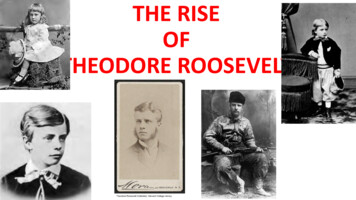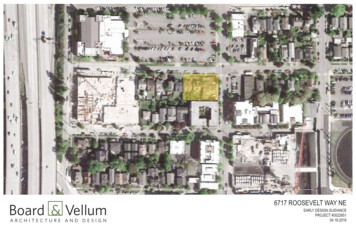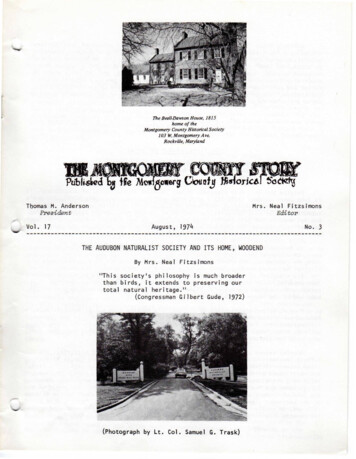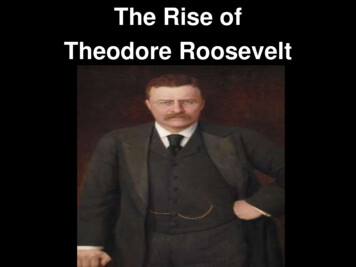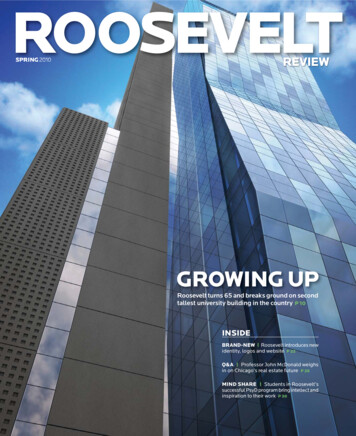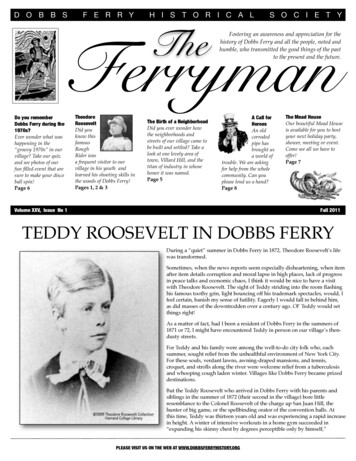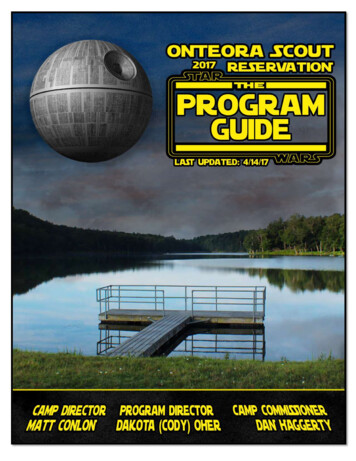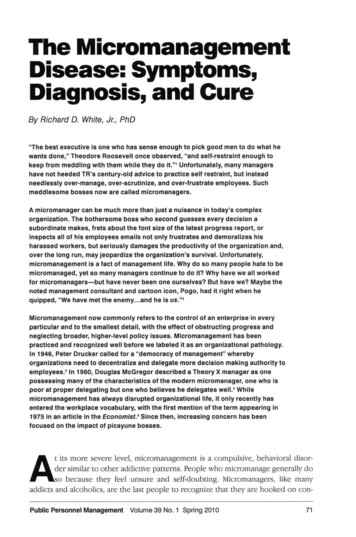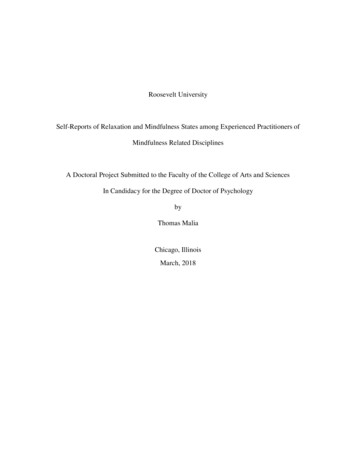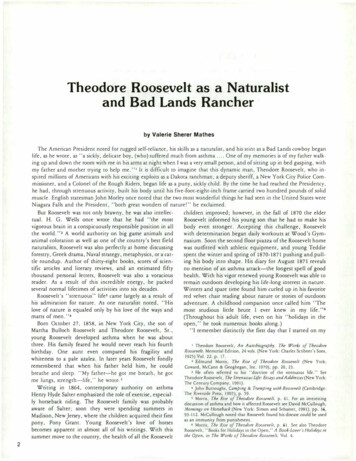
Transcription
Theodore Roosevelt as a Naturalistand Bad Lands Rancherby Valerie Sherer MathesThe American President noted for rugged self-reliance, his skills as a naturalist, and his seine as a Bad Lands cowboy beganlife, as he wrote, as "a sickly, delicate boy, (who) suffered much from asthma . One of my memories is of my father walk ing up and down the room with me in his arms at night when I was a very small person, and of sitting up in bed gasping, withmy father and mother trying to help me." 1 1c is difficult to imagine that this dynamic man, Theodore Roosevelt, who in spired millions of Americans with his exciting exploits as a Dakota ranchman, a deputy sheriff, a New York City Police Com missioner, and a Colonel of the Rough Riders, began life as a puny, sickly child. By the time he bad reached the Presidency,he had, through strenuous activity, built his body until his five-foot-eight-inch frame carried two hundred pounds of solidmuscle. English statesman John Morley once noted that the cwo most wonderful things he had seen in the United States wereNiagara Falls and the President, "both great wonders of narure!" he exclaimed.But Roosevelt was not only brawny, he was also intellecchildren improved; however, in the fall of 1870 the elderrual. H. G. Wells once wrote that he had "the mostRoosevelt informed his young son that he had to make hisvigorous brain in a conspicuously responsible position in allbody even stronger. Accepting this challenge, Rooseveltthe world. " 2 A world authority on big game animals andwith determination began daily workouts at Wood's Gymanimal coloration as well as one of the country's best fieldnasium. Soon the second floor piazza of the Roosevelt homenaruraliscs, Roosevelt was also perfectly at home discussingwas outfitted with athletic equipment, and young Teddieforestry, Greek drama, Naval strategy, metaphysics, or a catspent the winter and spring of 1870-1871 pushing and pulltie roundup. Author of thirty-eight books, scores of sciening his body into shape. His diary for August 1871 revealstific articles and literary reviews, and an estimated fiftyno mention of an asthma attack-the longest spell of goodthousand personal letters, Roosevelt was also a voracioushealth. With his vigor renewed young Roosevelt was able toreader. As a result of this incredible energy, he packedremain outdoors developing his life-long interest in nature.several normal lifetimes of activities into six decades.Winters and spare time found him curled up in his favoriteRoosevelt's "strenuous" life' came largely as a result ofred velvet chair reading about nature or stories of outdoorshis admiration for nature. As one naruralist noted, "Hisadventure. A childhood companion once called him "Thelove of narure is equaled only by his love of the ways andmost studious little brute I ever knew in my life."6marts of men. " 4(Throughout his adult life, even on his "holidays in theBorn October 27, 1858, in New York City, the son ofopen," he cook numerous books along.)Martha Bulloch Roosevelt and Theodore Roosevelt, Sr.,"I remember distinctly the fuse day that I started on myyoung Roosevelt developed asthma when he was aboutthree. His family feared he would never reach his fourthTheodore Rooscvclc, An Autobiography. The Works of TheodoreRoosevelt, Memorial Edition, 24 vols. (New York: Charles Scribner's Sons,birthday. One aunt even compared his fragility and1925) Vol. 22, p. 17.whiteness co a pale azalea. In later years Roosevelt fondly2 Edmund Morris, The Rise of Theodore Roosevelt (New York:remembered that when his father held him, he couldCoward, McCann & Geoghegan, Inc. 1979), pp. 20, 23.) He ofrcn referred ro his "doctrine of the Strenuous life." Secbreathe and sleep. "My father-he got me breach, he gotTheodore Roosevelt, The Strenuous Life: Essays and Addresses (New York:me lungs, strength-life," he wroce.iThe Century Company, 1901).Writing in 1864, contemporary authority on asthma John Burroughs, Camping & Tramping with Roosevelt (Cambridge:The Riverside Press, 1907), p. 59.Henry Hyde Salter emphasized the role of exercise, especial ' Morris, The Rise of Theodore Roosevelt, p. 41. For an interestingly horseback riding. The Roosevelt family was probablydiscussion of asthma and how it affected Roosevelt sec David McCullough,aware of Salter; soon they were spending summers inMornings on Horseback (New York: Simon and Schuster, 1981), pp. 36,93-112. McCullough noted that Roosevelt found his disease could be usedMadison, New Jersey, where the children acquired their fuseas an immunity from punishment.pony, Pony Grant. Young Roosevelt's love of horses' Morris, The Rise of Theodore Roosevelt, p. 6 I. Sec also Theodorebecomes apparent in almost all of his writings. With thisRoosevelt, "Books for Holidays in the Open," A Book-Lover's Holidays inthe Open, in The Works of Theodore Roosevelt, Vol. 4.summer move to the country, the health of all the Roosevelt12
career as zoologist, "7 Roosevelt wrote in his Autobiography.One day in New York City while walking past a market, henoticed a dead seal , which immediately filled him " withevery possible feeling of romance and adventure . " 8 Hehaunted the market as long as the seal remained and immediately wrote a hisrory of the strength of a seal. After acquiring the skull, Roosevelt and two of his cousins startedthe Roosevelt Museum of Natural Hisrory in the familyhome in 1867. Years later his collection was given ro the, Roosevelt, An Autobiography, p . lB . O rigin all y publ ished inAmen'can Museum joumal(Ma y 19 1B), see Theodo re Roosevelt, " My Lifeas a N. turoliSl , " in The Works 0/ Theodore Roosevelt, Vol. 4, pp.592-602 . Roosevelt , An Autobiography, p . l B.tThe 2bove incide nts are noted in Morris, The RIle of TheodoreRoosevelt, pp. 47-4B.,0 Paul Ru ssell Cuuight, Theodore Roosevelt, The Natura",t (NewYork : Harper and Brothers , 1956), p . 4." Roosevelt , An Autobiography, p . 22." Morris, The Rise o/Theodore Roosevelt, p . 62." Roosevelt , An Autobiography, p . 23.Posed in buckskins and armed with his rifle and a hugehunting knife, Roosevelt looked every inch the frontiersman in this and other photographs that he sent to friendsand family "back east" during his sojourn in the LittleMissouri Bad Lands.-State Hilton'ca! Society0/ NorthDakota CollectionSmithsonian Institution and the American Museum ofNatural Hisrory , the latter of which his father helped foundin 1869 . At first young Roosevelt was a general collecror ofnature , from minnows ro salamanders, but eventually hebegan ro specialize in birds . In his writings about the BadLands and about travels abroad as an adult, he constantlyreferred to the music of various birds.His hobby frequently caused embarrassment for his family . Absentmindedly, he once raised his hat on a streetcar ingreeting Mrs . Hamilton Fish ; several ftogs leaped out, causing consternation to fellow passengers. The chambermaidcomplained she was unable to do the family laundry as longas a snapping turtle was tied to the sink's leg. GueStS oftensat apprehensively wondering what might leap out at themand carefully checked water pitchers for signs of Teddie 'spets . His mother once threw out a litter of mice discoveredin the ice box , and finally even the good-natured cookrebelled when ordered by the young man to boil his freshlykilled woodchuck , skin and all, for twenty-four hours .9 Hisboyhood Notes on Natural History reveal other interestingepisodes. On August 3, 1872, he found a nest of grey squirrels at the summer home in Dobbs Ferry, New York. Afterunsuccessfully trying to get the little ones to take milk, hefinally in desperation filled a syringe, and when one maIeseized it , he let him have as much as he could drink. Afterweighing the squirrel , Roosevelt then pumped the othersfull of milk to the same weight. His notebook enrry readthat one died, but the "others lived happily on. " '0Roosevelt had his fust encounter with actual wildernesson a family expedition to the Adirondacks in the summer of1871. Despite sleeping on the ground and the rigors ofcamping , his health was never better. That year he continued using his athletic equipment, was tutored privatelyin English , French , German, and Laun , and learned a newskill , taxidermy , ftomJohn G . Bell, who worked withJohnJames Audubon. In the summer of 1872 his father gave himhis first gun for collecting purposes, but only when thefamily realized that his eyesight was poor and had him fitted for glasses did his shooting improve . "I was very nearsighted , so that the only things I could study were those Iran against or stumbled over, " II he wrote . "Through themiraculous little windows chat now gripped his nose , theworld leaped into pristine focus, disclosing an infinity ofdetail , of color, of nuance, and of movement just when thescreen of his mind was at its most receptive ," wrote hisbiographer, Edmund Morris . 12 Roosevelt himself noted , "Ihad no idea how beautiful the world was until I got thosespectacles. " " But fortunately for his reading public , hismyopic years resulted in an abnormal sensitivity to soundwhich became one of the best features of his wildlifewrmngs.Armed with his new glasses, his truSty gun, and his newlyacquired taxidermy skills, young Roosevelt set out with hisfamily on their second trip to Europe in the fall of 1872. Hisfirst real collecting began on the trip up the Nile in Egypt.His new glasses allowed him to focus on smaller animalswhere before he had been forced to concentrate on longer ,slower-moving ones. His main interest soon became thestudy of birds, a hobby he practiced the rest of his life,3
especially during wilderness retrears in the Bad Lands ,Yellowstone , Brazil, and Mrica.During this aip , his family and friends were forced to putup with smelly arsenic, which he used to cure specimens:Well over one hundred birds were catalogued on thatjourney. There were moments of suffering with his hobby ,even personal suffering . He wrote in his Autobiography," especially on one occasion when a well-meaning maid extracted from my taxidermist 's outfit the old tooth-brushwith which I put on the skins the arsenical soap necessary fortheir preservation, partially washed it, and left it with therest of my wash-kit for my own personal use ." '· During thesummer of 1873, Roosevelt and Ills younger brother Elliottstayed in the home of Dr. Minkwitz, a Dresden CiryCounselor. The Minkwitz family did not much approve oftheir young guest 's naturalist activities, confiscated hisarsenic, and threw his mice out the window. They probablyNew York City bedroom after finding a snake under hisolder brother's bed .In the fall of 1876 Roosevelt enrolled at Harvard , wherehe engaged rooms on the second floor of a boarding house .He surrounded himself with his birds , snakes, salamanders,and a huge tortoise that got out of his pen one day and wasdiscovered escaping down the hall by the hystericallandlady. Asked to present a paper on the gills of crustaceans at Harvard before the Natural History Society , hewent to Boston one day for a basket of lobsters . On thereturn aip in the saeetcar, several escaped and crawled outon the seat, causing great excitement among the femalepassengers . "Before long Roosevelt had joined many of Harvard'sclubs, including the Rifle Club , Glee Club , Natural HistorySociety , and the Nuttall Ornithological Club . In addition ,he engaged in boxing , wrestling, body building, and a-- - --- -- The rugged western life to which Roosevelt aspired was captured by Frederick Remington in il/ustrations. Thisdrawing, titled "Roped! ", was published in Roosevelt's Ranch Life and the Hunting Trail in 1888.- State Historical Society of North Dakota Collectiondisliked having his hedgehog skins hanging out their windows. By this time brother Elliott also wearied of the smellsof arsenic and of sharing the room with dissected m ice anddead owls .Upon their return from Europe the Roosevelt family moved into a new home , closer to Central Park with a moresuburban atmosphere . The top floor had a fully equippedgymnasium. With the continued interest of his less-thanhealthy children always on his mind, the elder Roosevelt inthe spring of 1874 began taking the family to Oyster Bay,Long Island, where a permanent summer house , Tranquill ity, was rented . Now young Roosevelt was exposed to thefl ora and faun a of Long Island and happil y engaged inswimming , rowing , horseback riding, and long jauntsthrough the woods with gun and notebook in hand . BrotherElliott continued to share a bedroom but not the hobby; heonce drew a chalk line along the middle of the floor in their4weekly dance class, taught Sunday school, hunted in thewoods around Cambridge, stuffed and dissected hisspecimens, participated in poetry-reading sessions , and tookhis various academic classes. As Morris notes, Roosevelt" plotted every day with the methodism of a Wesyleyanminister. " 16During his freshman year he became friends with HenryDavis Minot , who shared his love of birds . The cwo spentweekends at Minot's home comparing notes or engaging innature jaunts . In June 1877, they spent a week in theAdirondacks at a time when the birds were in full voice andplume . While hunting deer one dark night before the moonhad risen, the quiet of the night was broken by the hermit. Ibid., p. 25." Cutright, Theodore RooJe"'/t, The Natura/ist, p . 25." Morris, The Rise of Theodore RooJeve/t, p . 89.
Roosevelt's Elkhorn Rancn lay along the Little Missouri in the heart of the Bad Lands north of Medora. ArtistCharles Miller's sketch depicts the place as it would have looked after several years under Roosevelt's ownership.The ranch location is now part of the Theodore Roosevelt National Park complex in western North Dakota.- Slate Hi.rlonCo/ Socielythrush ' 'until the sweet, sad music seemed to fill the very airand to conquer for the moment the gloom of the night ; andthen it died away and ceased as suddenly as it hadbegun . .! shall never forget it, " wrote the observanteighteen-year-old Roosevelt in his notebook ." Their jointeffort resulted in the privately-financed publication of TheSummer Birds of the Adirondacks, a scientific catalogue ofninety-seven species. This publication was duly noted byzoologist C. Hart Merriam in the Bulletin of the NuttallOrnithological Society in April 1878. Roosevelt was well onhis way to becoming a renowned naturalist. Unfortunately ,further writings with Minot were ended when Minot's fatherremoved him from Harvard and placed him in his own lawoffice. However, during his junior year Roosevelt wrote andprinted Notes on Some of the Birds at Oyster Bay. 18Roosevelt's happy existence was shattered on February 9,1878 , by the unexpected death of his beloved father. Thatsummer young Roosevelt spent a strenuous time among thewilds of Oyster Bay , rowing and riding in an effort toassuage his grief. Lightfoot , his horse, probably suffered themost as Roosevelt whipped both into a frenzy of exhaustion.The poor animal had to endure tremendous feats , includingone twenty-mile gallop. Roosevelt confided to his diary oneday: "My ride was so long and hard today that I fear it mayhave injured my horse. "19 Yet several days later he wasagain astride the same animal.The last weeks of his vacation were spent in the wilds of" Ibid., p. 9 1; sec also CU[fight , Theodore RooI ve/l, Ihe Nolurali.rl,p . 17.II CU[fight , Theodore ROOI ve/l, Ihe Nalura/ul , pp . 18· 19,2).19 Carleton Putnam , Theodore Roosevelt: Vol. I: The Formative Years1858- 1886 (New York : Charles Scribner's Sons, 19)8), p. 146.10 For information about his trips to Maine , see Morris. The Rue 0/Theodore Roo.reve/I, pp . 110·111 , 117· 118; and Putnam , TheodoreRoo.reve/I, The Formalive Years, pp . 1)3 · 164." McCullough , Morning.r on Hor.reback, p. 287. See also Morris, TheRue a/ Theodore Roo.revell, pp . 104 , 11 3, 241.0/ NorthOokala Col/ecli,,"Aroostook Country in Northern Maine at Island Falls with acousin and a friend. He became acquainted withbackwoodsman Bill Sewall , and after many long hikes thetwo became close friends , In later years Sewall and hisnephew Wilmot Dow would join Roosevelt in ranching inthe Bad Lands, Roosevelr made two more trips to IslandFalls before leaving Harvard, During his March 1879 visit,he trailed a caribou for thirty-six hours on snowshoeswithout benefit of tent or blanket under the expertguidance of Sewall. He returned from the trip loaded withtrophies ; he had also kept their table supplied with rabbitand partridge.During his September 1879 visit , Roosevelt climbed Mt.Katahdin , the highest mountain in Maine, carrying a fortyfive pound pack . He triumphantly reached the top withSewall and Dow despite having lost a shoe in the Stream andreplacing it with a moccasin that gave little protection , ThenRoosevelt and Sewall set out on a futy-mile, six-day trip upthe Aroostook River in a pirogue, often dragging or pushingthe heavy canoe through rapids , spending ten hours a day inwater up to their hips. And finally before returning toBoston, the three men undertook a thisd jaunt of one hundred miles in three days. Roosevelt had really accepted hisfather's challenge to building up his body, oHowever, the focus of Roosevelt's life was about tochange. During his junior year, through a friend and fellowclassmate, he was introduced to Alice Hathaway Lee,described by her contemporaries as "exceptionally bright,""the light of the party," and an "enchanting creature ."Roosevelt, swept off his feet , even had Lightfoot shippedfrom home so he could gallop the twenty-four miles daily rovisit Alice, whom he called his "star of heaven," his"pearl," and his "pure flower." When she died in 1884after the birth of their only child, Roosevelt wrote in anotherwise empty diary for the year, "The light has gone outof my life, "21 after making a large X on February 14.5
In June 1880 Roosevelt graduated from Harvard magnacum laude with an honorable mention in Natural History.However, before his October wedding , he and Elliott set outon a six-week hunting trip beginning in Illinois and thenIowa, where by the end of six days Roosevelt had brokenboth guns, been binen by a snake , and had been thrownfrom a wagon . However, this did not deter the two brothersfrom moving on to the Red River of the North in Minnesota . At the end of their trip on September 20, 1880, theycompared their game bags; Elliott had bagged 201 animalswhile his older brother had 203 22Following his Octob r 1880 wedding to Alice Lee in theUnitarian Church , Roosevelt plunged into classes at Columbia Law School. In his characteristic Rooseveltian walk ,described by Morris as "arms pumping, toe caps shootingout sideways, every heel fall biting like a pickax , "2} hecovered the three miles to school in forty-five minutes. Afterclass he headed for the Astor Library to continue work onThe Naval War 0/ 18 12, which had been started during thewinter of 1879-80. He also began to frequent the headquarters of the Twenty-First District Republican Association . Nominated on October 28, 1882 , for his assemblydistrict, Roosevelt was elected in November and the following month placed the manuscript of The Naval War 0/1812in the hands of the publishers.His record in the 1882 legislature assured him ofrenomination, and he was easily elected by a twO-to-onemajority . Then in May 1883 , several weeks after adjournment, he accepted the invitation of Commander HenryHoneychurch Gorringe to join him on a buffalo hunt in theBad Lands of Dakota Territory. On September 3, Roosevelt ,loaded with his duffel bag and gun case , boarded the trainalone because Gorringe had decided four days earlier not toaccompany him . Descending at Little Missouri onSeptember 8, 1883 , Roosevelt spent his first night in theBad Lands in the Pyramid Park Hotel in the only empty COtof fourteen in a long unpartitioned room .After some persuasion Joe Ferris, barn superintendent forCommander Gorringe, agreed to guide Roosevelt in thesearch of buffalo . But flIst Ferris took the young Easterner tothe Maltese Cross Ranch, the home of his brother Sylvaneand Bill Merrifield, some seven miles south of LittleMissouri . All three men were Canadians who had migratedto the Dakotas only twO years before. The next Stop was atthe ranch of Gregor Lang 24 at the mouth of the Little Cannonball , which would serve as hunt headquarters . Fortunately , his years of tramping through rugged terrain as ayoungster either to hunt game or coll ect specimens for hisnaturalist collection proved to be an excellent traininggtound for his initial visit to Dakota. For five days inceaseless rain, Roosevelt and Ferris trudged through thesticky gumbo clay of the Bad Lands, rerurning every nightwith both men and horses covered ftom head to foot withmud . Finally on the sixth day they spotted th ree specks onthe horizon, but Roosevelt only succeeded in wounding oneof the bulls , which charged him and then ran off. Nightfallfound the twO men miles ftom headquarters, and they wereforced to bed down under the stars until a cold rain wokethem.6During the seventh day Roosevelt ' horse stepped into ahole and threw him ; later both horse and rider were almostswallowed by quicksand . Bur depite these hardshipsRoosevelt enjoyed himself greatly. By the time they return ed to the Lang ranch, he had decided to invest in the cattleindustry. When Lang , already involved with others, refusedhis offer of partnership , Roosevelt made an arrangementwith Sylvane Ferris and Merrifield and handed over a checkfor 14 ,000 to buy cattle, which they would manage onshares. While his twO new partners headed to Minnesota tobreak their contract with their Minnesota investors,Roosevelt returned to the hunt and finally on September 20in Montana bagged his first buffalo ."The following day Roosevelt headed back to LittleMissouri to catch his train home, where he plunged back into the political world . The death of his mother in mid February 1884 , followed eleven hours later by the death ofhis wife, shane red the young man . And not until Junecould he lay aside his assemblyman 's duties and head westagain . Early in the month " he hiked away to the wildernessto get away from the world . He went Out there a brokenhearted man , "26 recalled fellow assemblyman Isaac Hunt.Discovering that his herd of 440 had weathered the mildwinter with only a minor loss, Roosevelt gave Ferris andMerrifield an additional 26 ,000 to buy a thousand morehead . While they were purchasing cattle in St. Paul,Roosevelt headed his horse Manitou out ontO the Bad Landsto enjoy the sights and sounds of narure as he gallopedalong the gtound, btoken here and there with buttes,ravines, and coulees. He made a stop at the growingmetropolis of Medora, founded on April Fool 's Day 1883 byAntoine-Amedee-Marie-Vincent-Amat Manca de Vallombrosa, the Marquis de Mores, a wealthy Frenchman and thehusband of Medora von Hoffman , daughter of a wealthyWall Street banker. Naming the town after his wife, theMarquis had established a ranch and formed the NorthernPacific Refrigerator Car Company with partners in the hopesof slaughtering range catrle, dressing them in his packingplant on the east side of the Little Missouri , and sending thecarcass beef east in refrigerator cars . Roosevelt met the Marquis and his lovely wife during his second visit to the Bad" Morris, The Rise o/Theodore Roosevelt, pp. 131-132; and Pum. m,Theodore Roosevelt, the Formative Yean, pp . 199-208." Morris, The Rise o/ Theodore Roosevelt, p . 137." Lincoln A. Long, Ranching with Roosevelt (Philadeiphia :J.B . LippinCOttCompany, 1926). Lang was sixteen when Roosevel t first came to theBad Londs.1) For information about Roosevelt 's flIst uip ro the Bad Lands, seeRoosevelt , An Autobiography, pp . 113 - 115 ; Morris, The Rise o/TheodoreRoosevelt, pp . 200-225 ; Putnom , Theodore Roosevell, the FormaliveYears, pp. 310-344 ; McCullough , Mornings on Horseback, pp . 316-323;and Cutright, Theodore Roosevelt, Ihe Naturalist, pp . 38-42. For a generaldescription of his years in the Bad Lands see Herman Hagedorn , Rooseveltin Ihe Bad Lands (Boston : Houghton Mifflin Company , 192 1); Alvar W .Carlson , " Roosevelt and the Badlands; The Persi su : n cc:: of Error inGeographic Location," j ournal 0/ the West, 9 (OctOber 1970), pp .469-486, deals primasily with proving that the Roosevelt ranches werelocated in western North Dakota , not South Dakola or Montana as manywriters have claimed . See also Ray H . Manison , " Roosevelt and theStoc kmen 's72-95 ; .nd. HenryCOUrt BraceAssociation, " North Dakola Hislory, 17-2 (April 1950), pp .17-3 Uuly 1950), pp . 175-201.F. Pringle , Theodore Roosevell: A Biography (New York: Hasand World , Inc., 1956), p . 38.
Lands. He also took the time to visit the weekly newspaperin Medora, the Bad Lands Cow Boy. The next issue of theweekly was impressed with the new dude in town:"Theodore Roosevelt, the young New York reformer, madeus a very pleasant call Monday, in full cowboy regalia. NewYork will certainly lose him for a time at least, as he isperfectly charmed with our free Western life . . "27The Maltese Cross, located a few miles south of Medora,was on a popular trail, and dozens of cowboys continuallytraveled past Roosevelt 's door; many stopped to pass thetime of day. Desiring a location with complete solitude inorder to write, Roosevelt set out to find a more isolated site.He headed in the opposite direction from the Maltese Crossand some thirty miles later along the Little Missouri river ina stretch of bottomland found the perfect spot. One daywhile exploring the property with Sewall, the cwo men cameupon interlocked antlers of cwo elk who had died in combat-the name Elkhorn became permanently associatedwith the new ranch . Needing partners and someone to buildhis dream ranch house of hewn logs with a veranda where hecould sit in his rocking chill and read poetry or watch hiscattle, he wrote his friends Bill Sewall and Wilmot Dow toinvite them to join him. In a letter to his sister Anna onJune 17 he informed her he was having a glorious time, hadjust spent thirteen hours in the saddle , had never been inbetter health, and had recently shot an antelope. 1 On July 1, 1884 , Roosevelt left Medora for New York . Inless than a month , he had surveyed his cattle , signed over 26,000 for more cattle, participated in a roundup , locateda site for a second ranch , traveled to Miles City , Montana,with the Marquis on cattle business, and spent five daysalone on the plains with only his rifle, a book , a blanket, anoilskin , a metal cup, some tea, salt, and dry biscuits. Alongthe way he got bogged down in the quicksand and shot anantelope .19Following a quick visit with his sister and young daughterin New York in August, Roosevelt was back in the BadLands accompanied by Sewall and Dow. Anxious to go tothe Big Horn country of Wyoming to hunt grizzly but detained until August 18 by the shortage of extra horses ,Roosevelt expended his energy riding. For seventeen days heranged the Bad Lands, riding on one day as much asseventy-cwo miles becween dawn and darkness . Thisstrenuous exercise and other equally grueling work would11Morris, The Rue of Theodore Roosevelt, p . 276.28Theodore Roosevel t lO Anna Roosevelt , Ju ne 17. 1884, The Letters ofTheodore Roosevelt, selected and edited by Elt ing E. Morison, 2 vols.( ambridge: Harvard Uni ve rs ilY Press, 195 1) , Vo l. I, p . 73.19 For information about this second trip to the Bad Lands, sec Morris,The Rue of Theodore Roosevelt, pp . 268-278; McCull ough , Mornings onHorseback, pp . 323-333; Putnam , Theodore Roosevelt, the FormativeYears, pp . 450-462; wd Hagedorn , Roosevelt in the Bad Lands, pp .148-1 54.'" McCullough , Mornings on Horseback, p . 350." Morris. The Rue of Theodore Roosevelt. p . 285." Roosevelt , An Autobiograp hy, p . 12 7.)) For info rmation about the third Bad Lands trip . sec Morris, The Riseof Theodore Roosevelt, pp . 28 1-288; McCull ough , Mornings on Horseback,pp . 333-3 36; Putnam , Theodore Roosevelt, the Formative Years, 496-490 . For TR's fourth uip to the Bad Lands, sec Morris, The Rue ofTheodore Roosevelt, pp . 292-297; McCullough , Mornings on Horseback,pp . 337, Putnam , Theodore Roosevelt, The Formative Years, pp . 507-5 18.soon shrink him into a husky one hundred fifty pounds,which Sewall described as " clear bone, muscle , and grit. "'"In mid -August Roosevelt , guided by Merrifield and accompanied by a cook who doubled as a teamster, headed into the Big Horn country. Since Alice 's death his days hadbecome "a monotonous record of things slain. "31 This tripwas no different: in forty-seven days, he shot a tOtal of onehundred seventy animals- deer, elk, and a variety of smallgame, including rabbit, grouse , dove , and teal. He drovehimself mercilessly, covering nearly one thousand miles onfoot and in the saddle. Weather conditions were severe withbelow-freezing temperatures and huge hailstones. OnSeptember 13, a cwelve-hundred pound grizzly reared uponly eight paces in front of him. A perfect shot to the headbrought the animal down. Headed for home on OctOber 4with only seventy-five miles left to go, Roosevelt , as impatient as ever , and Merrifield left the wagon and extra ponieswith the driver and rode non-stOp by night to the MalteseCross. They had plodded alongside the wagon, weary andhot all day, but, he wrote :Under the bright moonlight, and then under thestarlight, we loped and cantered mile after mileover the high prairie. We passed bands ofantelope and herds of longhotn Texas cattle, andat last, JUSt as the fust red beams of sun flamedover the bluffs in front of us, we rode down intothe valley of the Little Missouri, where our ranchhouse stood. 31Mter a one-day recovery he rode an additional forty miles tovisit Sewall and Dow before leaving for New York. HHome during the first week of October, Roosevelt wasback astride M
the world. "2 A world authority on big game animals and with determination began daily workouts at Wood's Gym-animal coloration as well as one of the country's best field nasium. Soon the second floor piazza of the Roosevelt home naruraliscs, Roosevelt was also perfectly at home discussing was outfitted with athletic equipment, and young Teddie
